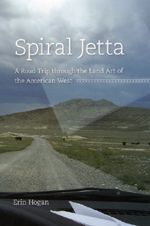An excerpt from
Spiral Jetta
A Road Trip through the Land Art of the American West
Erin Hogan
Spiral Jetty is about an hour’s freeway drive, then a half hour’s rural-highway drive, then an hour’s bone-jarring-road drive from Salt Lake City. It is accessible through the Golden Spike National Historic Site, the place where the Union Pacific joined the Central Pacific railroad to complete the first rail link between the coasts.
It is a beautiful drive the whole way, with mountains on your right as you head north. Once you exit I-15, you wind past the town of Corinne and then into Thiokol country—a name familiar to me as the employer of managers who turned a blind eye to the warnings of engineers about the cold and brittle O-rings that brought NASA’s Challenger down in 1986. Just before the bulk of the Thiokol complex you bear left onto a smaller road that eventually takes you to Golden Spike. In the middle of nowhere, or at least what I took to be nowhere at the time, there’s a railroad track, and I had to stop for a bright and shiny toylike two-car train pulled by a steam locomotive, obviously some demo for visitors to the site. I don’t know how far the train runs, but I suspect it’s not more than a few hundred yards. The trainmen gave me a jaunty wave as I waited for them to pass.
Though Golden Spike is the gateway to Spiral Jetty, the National Park Service doesn’t administer the work nor even monitor it closely. The jetty was acquired from Smithson’s estate in 1999 by the Dia Art Foundation, which plays such a role in most of the sites I was visiting that it could almost be considered the architect of my trip. The Dia Foundation was started in 1974 by a prescient German and an American heiress, Heiner Friedrich and Philippa de Menil, and, despite subsequent permutations and tribulations, it remains the signal institution in the United States committed to highly site-specific (and some might say, difficult) works. It supported—by buying land, commissioning works, paying stipends to artists, providing materials—much of the monumental art of the 1970s and 1980s, which, because of its size or ephemerality, couldn’t find expression in the standard gallery-museum circuit. Dia is now the custodian of Spiral Jetty and many of my other destinations, including Roden Crater, the Lightning Field, and, to a lesser extent, the town of Marfa, Texas. A few years ago the foundation opened Dia:Beacon, a breathtaking museum in the Hudson River Valley that is a contemporary art sanctuary, with every inch cultivated and plotted for a maximally aesthetic experience.
Some complain that the Dia “mafia” supports a small and privileged group of artists and is not attentive enough to different currents of artistic inquiry—like personal identity, social systems, or even history. It is true that Dia puts its money behind a very specific and limited type of work. It is also true that Dia puts its money behind the work I find most compelling—ambitious, beautiful, rigorous, geometric, engaged with questions of form rather than personality, aiming at the eternal without irony.
Knowing, then, that the Golden Spike park rangers could do little for me in terms of the Spiral Jetty, I checked in at the visitors center anyhow, mostly so that someone would be able to trace my last steps should any disaster befall me. I was relieved to learn that the park had the same directions that I did, and a ranger said that the park had even put up signs (“if they haven’t been stolen”) to direct visitors to the work. She said it would take about forty-five minutes to get there because of the condition of the road. I asked what would happen if I got stuck; she said I’d be out of luck, because there’s no cell phone coverage out there. She must have seen a look of alarm cross my face because she quickly added that at least one other person, a woman, had also stopped for directions and was already out there.
What followed was a drive on something that could be called a road only because it had boundaries on the left and the right. As soon as I left the visitors center parking lot, the road became so rutted that water was bouncing out of an open bottle in my cup holder. I couldn’t go more than twenty miles an hour without the sense that I was doing real damage to the car. At points the road smoothed out a bit and I could get up to about forty miles an hour, but only briefly and only after desensitizing myself to the sound of rocks constantly pinging up into the body of the car. It felt rough and dirty. Learning to drive in the suburbs of Honolulu, as I had, then being confined more or less to the civilized purviews of New England and engineered highways of Chicago, I’d never known the sensation of screaming and bouncing and whooping my way down a dirt road in a pickup truck as people do in Urban Cowboy, Footloose, and John Cougar Mellencamp videos. In fact, I think this was the first time I’d ever left a cloud of dust behind me.

I had been on this road for maybe fifteen minutes, gritting my teeth the entire way, when a Subaru blew by me, making me feel like an eighty-year-old driver, timid, hapless, and scared. I watched as the car tore up the road in front of me. Its dust cloud seemed endless, rolling over the landscape and filling me with trepidation about how far I still had to go.
There were four or five signs pointing toward the jetty, which was a good thing because my directions, which were actually quite thorough, included steps like the following:
Drive 1.3 miles south. Here you should see a corral on the west side of the road. Here, too, the road again forks. One continues south along the west side of the Promontory Mountains. This road leads to a locked gate. The other fork goes southwest toward the bottom of the valley and Rozel Point. Turn right onto the southwest fork, just north of the corral. This is also a Box Elder County Class D road.
And
Continue 2.3 miles south-southwest to a combination fence, cattle guard #4, iron-pipe gate—and a sign declaring the property behind the fence to be that of the “Rafter S Ranch.” Here too is a “No Trespassing” sign.
What is a Box Elder County Class D road? How could that detail possibly be helpful when sitting at a fork confronting three identical gravel roads? The “combination fence, cattle guard #4, iron-pipe gate” sounds like text you would read on a contemporary art museum’s label, that strange combination of informative yet useless detail. These directions only served to confuse me, so I continued to thank God for the signs. Without them, I would just have sat in my overheating car, puzzling over which direction was south, helped little by the noon sun directly overhead. I regretted not bringing a compass. I also regretted never having learned to read one.
I continued poking along, wincing with every rut and bump. As the road wound its way between two low ranges, it worsened. Ruts turned into chasms, gravel turned into real rocks. Impelled by some curiously human instinct, I started to speed up, hoping that the faster I went the faster it would be over. I recognize, of course, that this was precisely the wrong thing to do, but just as I drive faster when I’m running out of gas, I couldn’t help but inch the car up to thirty miles an hour, literally bouncing in my seat, driving my little Jetta as if it were an off-road vehicle in an extreme road rally, furiously turning the wheel, bouncing along, driving by intuition rather than reason. There were so many pitfalls to avoid—huge potholes, large pointed rocks everywhere underneath me—that to reason my way through them would have been impossible, or at least too time consuming. Instead I gripped the wheel, stopped thinking about all the potential disasters and imagining the hiss of a shredded fuel pump, and prayed that the woman out there ahead of me was a kindly soul who would pick up my parched carcass on her way out. The long dust trail of the Subaru had vanished into the horizon, which meant that the road went far beyond what I could see.
Michael Kimmelman, in his book The Accidental Masterpiece, describes the journey: “To drive from the [Golden Spike] monument to the jetty in summertime is a spectacularly beautiful ride through an empty valley rimmed by mountains, with rushes of cranes flying overhead and fields of black-eyed Susans rising into the rocky slopes, the valley spilling suddenly down to the lake” (182). Kimmelman must not have been in the driver’s seat to be able to appreciate this, or perhaps he was driving a rental car and not worried about mortally wounding the most expensive purchase he’d ever made, sixteen hundred miles from his front door. I was in such a state of anxiety that the landscape escaped my notice. I could feel the heat of the day and, when idling and catching my breath, hear the buzz of the insects. But I was fixated on the road, the rocks, the ruts. Later, looking at the pictures I had taken, I could see that the ride was spectacularly beautiful—low-rise ranges and hills and bluffs, the Great Salt Lake emerging and receding with every turn. But that was in retrospect. At the time, I was only aware of the car, the hot air, the relentless sun. I pressed on, wincing and moaning and saying “ow” aloud for another half hour.
Finally I came to this juncture:
At this gate the Class D road designation ends. If you choose to continue south for another 2.3 miles, and around the east side of Rozel Point, you should see in the Lake a jetty (not the Spiral Jetty) left by oil drilling exploration in the 1920s through the 1980s. As you approach the Lake, you should see an abandoned, pink and white trailer (mostly white), an old amphibious landing craft, an old Dodge truck …
The old Dodge truck is less than half a mile from the jetty, and here I made a mistake, taking the left side of the fork rather than the right. Who could blame me? The directions said: “As you drive slowly past the trailer, turn immediately from the southwest to the west (right), passing on the south side of the Dodge and onto a two-track trail that contours above the oil-drilling debris below.” Instead of going from the southwest to the west, I guess I went from the southwest to the south, where I immediately ran into two guys in an equally inappropriate sedan with Massachusetts license plates. They told me to turn around, but I just backed up, parking my car next to the Dodge truck and amphibious vehicle because the directions warned that the road grew even worse beyond this point.

I put two bottles of water, my tape recorder, cameras, and Balance Bars into a bag and set off on foot. The Balance Bars had already melted into tumorous masses. After two minutes—so much for my trek on foot—the Spiral Jetty appeared on the left. My first impressions? Much smaller than I had expected, and much whiter. A long ways from the water, barely rising from the salty silty surface of the lake bed.

With my first earthwork now in view, I confronted a major discrepancy between what I had imagined—aided by images—and what the work actually was. The “real” size of the jetty bore no relation to my mental picture. I vividly remember the photograph on the cover of my very first art history book, Artforms by Duane Preble. It was the first image of Spiral Jetty I had ever seen. The book is now in its seventh edition and long ago changed its cover, but on my copy, the jetty seemed immense, like a coil that could stretch from California halfway to Hawaii. That photograph is like most other representations of Spiral Jetty in that it is aerial and unpopulated. Without human figures to put it in perspective, one assumes that it’s monumental, on the same vast scale as the surrounding landscape. In actuality it’s incredibly intimate, dare I say, even tiny. You can walk its spine in just a few minutes; three or four giant steps can cover the ground between the loops.
There were several people at the jetty when I arrived: the two architects whose car I almost hit, who were in the process of moving from Boston to San Francisco; two recently graduated artists (Lily and Michael) from Los Angeles, who apologized for blowing by me in the Subaru; and Heather, whom I at first took to be some sort of older hippie ecofeminist because she was pacing the jetty alone, in a pensive way. In fact she was an older hippie ecofeminist landscape architect, also from Los Angeles, traveling with her boyfriend, Bill. We quickly formed a tight group, sipping water and chatting about the experience. I wondered if we all should be more solitary, but that’s not really possible in such a small space. You couldn’t walk the jetty without running into someone; you couldn’t stand for a moment of quietude without hearing Lily tell Michael, “Look at this.”
I walked into the spiral and back out of it. I lay down in the center of it. I crisscrossed its rings. I crouched down and tasted the salt. I looked around, still overwhelmed by the work’s nonmonumentality. I tried to experience it physically, without processing it through any art-historical filter. But I couldn’t. I couldn’t separate my encounter with Spiral Jetty from the reading and thinking I had done about art of this era, by now deeply entrenched in my reptile brain. Trying to consider this object in isolation, to bypass art history, was like trying to knock an irritating song out of my head. I only managed to turn up the volume. It was with this force that the views of critics and historians crowded into my consciousness.

Like anything good and complex, Spiral Jetty can be thought of in many different ways. As lame as it sounds, those “ways” came down to two for me: space and time. Not small topics, I realize. But Spiral Jetty beautifully and subtly distills its experience into those fundamental categories.
When you first see the work and begin your short, sweaty trek toward it, you are forced to consider it spatially. On the drive and on the approach, coming up on the little rise before it, the sense of space is overwhelming. The dry bed of the Great Salt Lake stretches out in front of you, then turns hazily into water and melts into the horizon, where it collides with the vast sky. The mountains surround you, the light and heat envelop you. Being at Spiral Jetty engendered in me a sense of articulated space, one that wasn’t alienating because it was marked by mountains, edges, colors, which together staved off the disorientation I associate with open, ungridded space, like being on a sailboat at sea. All the elements of the landscape were so distinct, like Ellsworth Kelly’s planes of color, that they took on an unlimited sense. Sky meets water meets salt meets land meets mountain. The space is elemental and understandable, only a little overwhelming, and deeply inspiring.
One of the markers of this space is of course Smithson’s work itself. It orients you to your minimal place. Expecting it to be grand and finding it is not gives you a sense of human scale in a very unlikely place.
The question of scale and space in Spiral Jetty brings to mind the work of Michael Fried, critic, historian, poet. A versatile and creative thinker, Fried has covered centuries of art making, including the long-term project of tracing the roots of American minimalist art back to French painting of the eighteenth century. Yes, you heard me. The eighteenth century. His work on the 1960s has been so influential that even the critics who write about land art for the more-or-less general reader, such as Kimmelman in the New York Times and Calvin Tomkins in the New Yorker, can’t get through any sort of essay on this work without engaging Fried’s ideas. And neither can I.
Written just a few years before the creation of Spiral Jetty, Fried’s 1967 essay on minimalism, “Art and Objecthood,” is still considered to be among the most incisive works of American art criticism of the twentieth century. Like the unparalleled literary criticism of James Wood, “Art and Objecthood” not only described and evaluated then-contemporary art but also placed it within a broader philosophical framework. I have been chewing on this essay for years, and in what follows I’m sure I won’t be fair to it. I’ll just use it to outline some general themes.
Briefly put, Fried’s contempt for minimalism, or what he terms “literalist” art, is directed against its absolute reliance on physical presence and a viewer to discern that presence: “The experience of literalist art is of an object in a situation—one that, virtually by definition, includes the beholder” (153; Fried’s italics). The open acknowledgment of a beholder means that such a work, in concept and execution, is not so much art as theater. A literalist or minimalist work needs a viewer and isn’t an artwork on its own terms. Not only must someone hear the tree fall in the forest; the tree has to wait for someone to get there even to be a tree.
Hinged on the viewer’s presence, then, literalist work is diminished and fraudulent, according to Fried. Real art (a term he would never use, of course) exists in and of itself; it doesn’t need to be staged and then completed by a beholder. A Picasso in the middle of the desert is a work of art; it doesn’t need to be seen to be activated as art. However, a Robert Morris or a Donald Judd in the desert, which we’ll visit later, is merely an object, waiting in the sun for someone to apprehend and complete it. Art is keyed to itself, by virtue of features like size, material, duration, and internal relationships; objects are keyed to a viewer by the apprehension of them within their specific situation.
Is Spiral Jetty a Picasso in the desert? Fried wouldn’t think so. For him, land art would be the pinnacle of objecthood. I understand the argument that Judd’s boxes, sitting on the floor of a gallery, are in a viewer’s space, even in a viewer’s way. And if Judd played with this dynamic of objecthood in a gallery, land art would be, I was thinking, its supreme manifestation. Land art takes being in the way to an extreme, doesn’t it? Born of ripping and shredding the landscape, or relocating sixty-five hundred tons of earth, land art makes itself even more inescapable. It is its own stage, forcing you into a situation defined by itself. As I was to discover, you could totter off the edge of a chasm dug into a mesa; you could walk on landfill out into the Great Salt Lake. “You cannot avoid me,” land art and its makers say. “I am here in the way. You can’t drive around me. You can’t cross over me. You will pay attention.”
So I thought, in my understanding of land art and its relationship to theories of minimalism, most notably Fried’s. But being out in and on Spiral Jetty derails that thought. Imagining that this meager pile of rocks, against the broad lakescape of Utah, was forcing itself on me as a viewer didn’t quite ring true. How could a work be described as intrusive in Fried’s sense if one had to travel so far, so uncomfortably, and with such determination to see it? And how could the “objectness” of Spiral Jetty survive when for decades it was underwater, not even discernible to viewers and visitors? (I remember reading an essay on Spiral Jetty by Ann Reynolds, in which she admits she had never made the trip to see it. What was the point? At the time it was completely submerged.)
Standing in the sun, with the white and pink salt reflecting up on my face, I found that Smithson wasn’t insisting, in Fried’s sense, on a viewer. My tenuous connection of objectness and land art was fatally flawed from the start; even my conception of land art and monumentality wasn’t holding up. Land art was hardly minimalism writ large and in the hand of the natural.Too far away, too difficult to find, too elusive, too submerged. What other claims could I test out here?
![]()
Copyright notice: Excerpt from pages 12–24 of Spiral Jetta: A Road Trip through the Land Art of the American West by Erin Hogan, published by the University of Chicago Press. ©2008 by The University of Chicago. All rights reserved. This text may be used and shared in accordance with the fair-use provisions of U.S. copyright law, and it may be archived and redistributed in electronic form, provided that this entire notice, including copyright information, is carried and provided that the University of Chicago Press is notified and no fee is charged for access. Archiving, redistribution, or republication of this text on other terms, in any medium, requires the consent of the University of Chicago Press. (Footnotes and other references included in the book may have been removed from this online version of the text.)
Erin Hogan
Spiral Jetta: A Road Trip through the Land Art of the American West
©2008, 190 pages, 26 halftones, 1 map
Cloth $20.00 ISBN: 978-0-226-34845-2 (ISBN-10: 0-226-34845-8)
For information on purchasing the book—from bookstores or here online—please go to the webpage for Spiral Jetta.
See also:
- Read an interview with Erin Hogan
- Other books in the Culture Trails series
- Our catalog of art titles
- Other excerpts and online essays from University of Chicago Press titles
- Sign up for e-mail notification of new books in this and other subjects
- Read the Chicago Blog
